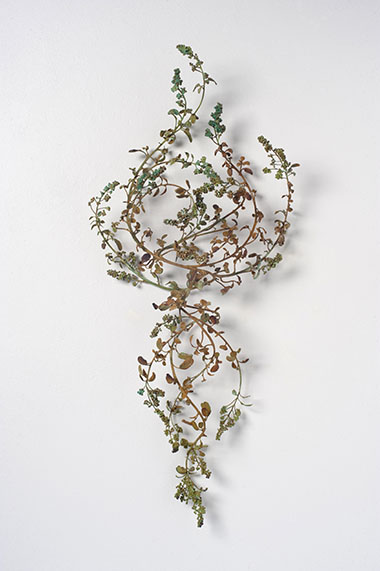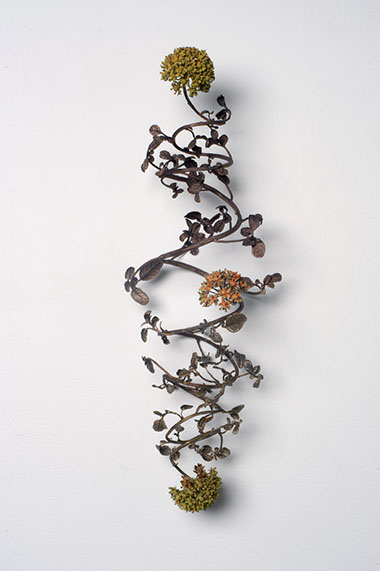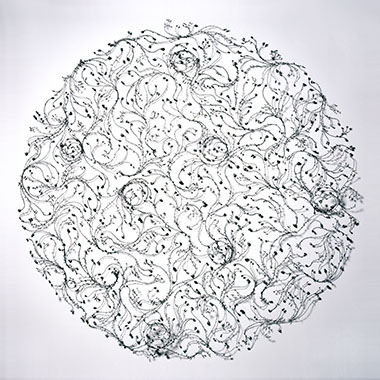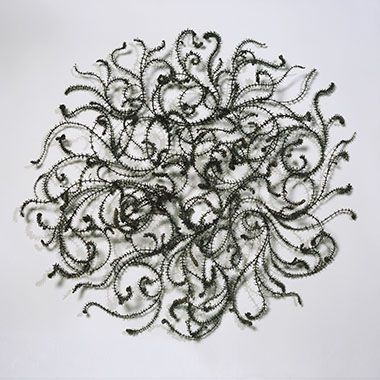Weeds
What we cannot see, we imagine. What we imagine, changes what we see.
I am inspired and perplexed by the kingdom of plants with which we share this planet—especially the natives, invasives, and other stoic upstarts that persist without our stewardship. These symbiotic partners give us everything we need to sustain life on Earth, indeed the very oxygen we breathe. As complex living organisms, they are the carbon sinks that will allow us to reduce global warming, control drought and maintain our water supply. Even the scruffy, weedy, urban medians corralled by concrete and asphalt contribute to the survival of our planet. And yet science tells us that most humans, and many animals, see only a wallpaper-like background when situated in a lush plant environment. Plants are "wildlife" just like animals; but as essential as they are to human life, endangered flora are rarely protected. Plants are our barometers—when a species dies, it predicts our future.

I cast plants into bronze, to create an enduring stand-in for the ephemeral originals, much like a memorial, to embrace the solemnity of their current demise. The notion of a memorial is significant in these times of climate change and extinction. Yet a memorial also links us to desire and hopefulness, because within the idealized natural spaces we cultivate in our imagination, and in the world around us, our best intentions flourish and proliferate.
The "Weeds: Chimera" sculptures are not merely bronze botanical representations, but deconstructed versions of themselves, reconfigured into eerie portraits of a world gone awry. Bronze gives authority and literal weight to the long-term and unintended effects of tampering with Nature. The "Chimera" pieces are hybrids of several plants that have a narrative relationship to each other, such as shared medicinal properties or a maligned invasive footprint. Through a series of purposeful, complex meanderings, these plants are grafted together into a single portrait to honor their shared characteristics; they are disturbingly co-joined to be irrevocably connected, yet steadfastly apart.
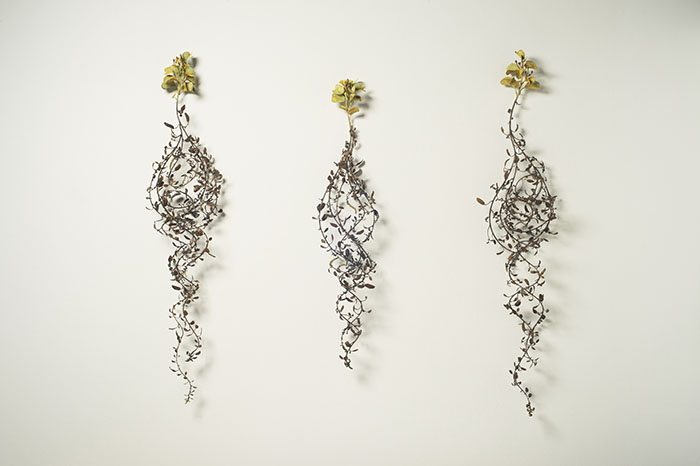
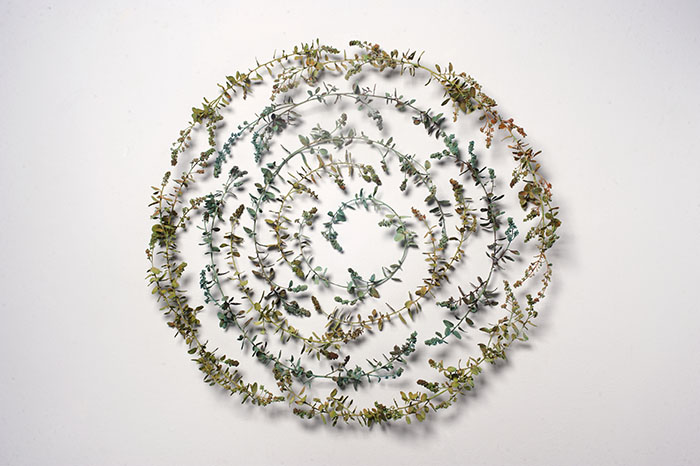
Sculptures in the "Weeds: Fractured Landscapes" explore the contradicting need to both idealize and modify the natural environment. Embracing both the scientific mind that must categorize and shape a new body of knowledge, and to the equal desire to order and shape unruly plants into a desirable form, these pieces respond to the patterns and structures in nature's systems. For example, Swarm Intelligence describes the collective behavior of decentralized systems such as flocks of birds in swirling flight, and Redundancy Theory argues that pattern has the paradoxical proclivity for creating newness out of consistency, with repetition as a primary means. These organizing principles are the language of Nature, but they are languages which we can only hear with our eyes, and which we can only interpret theoretically. Thus, the usual responses of our human senses, grounded in time and space, are out of synch with these communications and can become disconnected from Nature's lived experience.

The "Weeds: Plexus" series imagines and depicts aspects of Nature that we actually cannot see, like root systems and fungal networks, as a way of calling attention to the magic and mystery of the unseen and arguably the most important systems that keep our planet alive. Like a vital web of tree roots, or a system of thriving mycelium—the underground fungal networks that support all life—"Plexus" sculptures are constructed one small piece at a time. Cells are linked to cells, and part connected to part, forming hypnotic interlocking systems. The sculptures are assembled on the wall like aerial perspectives of the land, growing perpendicular to the force of gravity, in an exploration of line, shape, density and complex patterning, to elongate perception and attention through a thickening of experience.
An excerpt from the essay "To See or Not to See" by Suzanne Ramljak, for the upcoming monograph Beverly Penn: Foregrounding, expected Spring 2022, published by French and Michigan
Indeed, the importance of steering attention to the plant kingdom has never been more critical. Twice as many florae than fauna have gone extinct in the last two centuries, at a rate increased by 500 times due to human generated factors. In their demure yet essential ubiquity, plants are in need of a visual makeover that pulls them into the foreground. Botanical species, often overlooked when in our presence, are now literally disappearing from sight, a loss that is countered by Penn's alluring plant facsimiles.
The actual vanishing of plant-life is compounded by perceptual invisibility, a phenomenon known as "plant blindness." Coined by botanists Elisabeth Schussler and James Wandersee in 1998, the term describes an inability to notice plants in one's environment and a general neglect of their value or beauty. Plant blindness, a type of cognitive bias, filters out non-threatening elements like flora, which are stationary, similarly hued, and lacking active visual cues such as those found in humans or animals. As a result, the eye-brain system tends to register plants as background matter, low in a visual hierarchy that attends first to potentially dangerous elements. Plants are thus routinely ignored as we selectively direct attention in a blinkered quest for survival.
Today, the inability to distinguish and identify what is real leaves us adrift in a perceptual quandary. Ungrounded, perception is easily deceived and led astray. This chronic lack of focus returns us to the question of attention and to tactics of foregrounding found throughout Penn's keen art. More than just a passive recording, vision is an act of exertion and construction; linking what is seen with what is known. An interpretive act, not just a sensory encounter, vision includes judgment and choice. Seeing is not just an aesthetic experience, but also an ethical one. In Beverly Penn's quest to foreground plants for our rapt attention, she ultimately wields aesthetic means for ethical ends. Seducing us to see what has been overlooked, she positions us to better appreciate our own lives and that of other beings.
Postscript
"Nature provides," so my plant perceptive grandmother said. The northeastern farm of my childhood home was a bounty for foraging, as well as adventure and sometimes danger: nettles—to be avoided; thistles—eliminated; cockleburs—a nuisance; poison ivy—maligned. But raspberries, blackberries, pears, mint, apples, and nuts of all varieties were abundant gifts for the picking. And the hard-earned bounty from our annual cultivated crops anticipated the year's basic needs: 52 quarts of beans, 78 quarts of corn, 60 quarts of tomatoes, and healthy bins of potatoes and apples, sequestered in the cellar. It is only as an adult that I embrace this forced plant awareness with gratitude.
Beverly Penn lives and works in Austin, TX. She has been awarded grants and fellowships including a Fulbright, a Rockefeller Foundation Bellagio Residency, a Lux Art Institute Artist Residency, and a Tiffany Foundation Artist Grant. Her work is included in the collections of the National Museum of Women in the Arts, Yale University, Philadelphia Museum of Art, Cooper Hewitt Museum, and Racine Art Museum. She was awarded the State of Texas 3D Artist by the Texas Commission on the Arts in 2017. Beverly is a Professor in the School of Art and Design at Texas State University.
